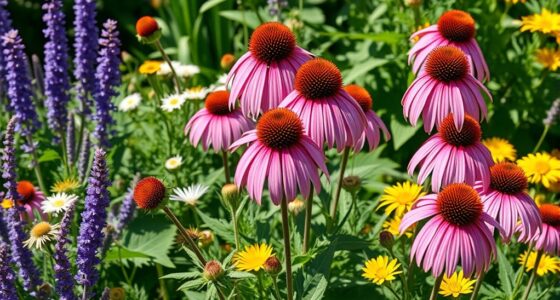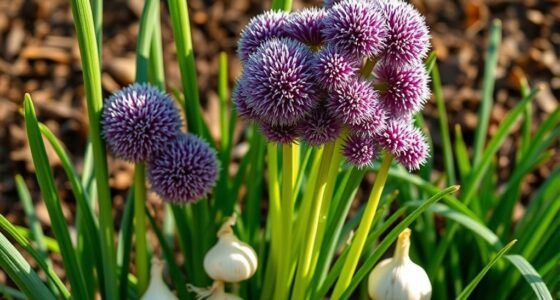Beans, beets, and brassicas can coexist if you understand their soil needs and pest risks. Beans prefer slightly acidic to neutral soil, while brassicas do well with similar pH but can tolerate slightly more alkaline conditions; beets are adaptable but share similar preferences. Pests can be a concern, with brassicas attracting worms and aphids, and beans being targeted by beetles. Strategic plantings, crop rotation, and companion plants like marigolds help keep pests in check. If you keep these tips in mind, you’ll create a healthy, balanced garden environment.
Key Takeaways
- Beans, beets, and brassicas can coexist with proper crop rotation and soil pH management.
- Brassicas may attract pests that could also affect beans and beets if not managed carefully.
- Companion planting with herbs and marigolds can deter pests and promote healthy growth among these crops.
- All three crops prefer slightly acidic to neutral soil (pH 6.0–7.0), facilitating their simultaneous cultivation.
- Strategic planning and pest vigilance are essential to prevent pest outbreaks and ensure friendly plant relationships.

Ever wondered how to grow a versatile and nutritious garden? If so, understanding how different plants interact is key, especially when it comes to beans, beets, and brassicas. These crops can coexist beautifully or cause trouble for each other—knowing their relationships helps you plan better. Starting with soil acidity, it’s important to remember that each of these plants prefers a specific pH range. Beans thrive in slightly acidic to neutral soils, roughly pH 6.0 to 7.0, while beets are adaptable but grow best in similar conditions. Brassicas like broccoli, cabbage, and kale prefer slightly more alkaline soils, around pH 6.0 to 7.5. To avoid nutrient competition or deficiencies, you should test your soil regularly and adjust the pH when necessary. This way, each crop gets the nutrients it needs without stressing the soil or each other.
Pest management is another crucial aspect when growing these vegetables together. Beans, beets, and brassicas each attract specific pests, and planting them close can sometimes lead to pest populations spreading more rapidly. For example, brassicas are highly susceptible to cabbage worms and aphids, which can also impact nearby plants. Beets are prone to leaf miners and downy mildew, while beans often attract bean beetles and root maggots. To minimize pest issues, practice crop rotation—don’t plant these crops in the same spot year after year. Interplanting can also help; for instance, planting beans alongside beets can help deter certain pests naturally, as beans can act as a trap crop for some insects. Regularly inspecting your plants and removing infested leaves or using organic pest controls like neem oil can keep pest populations in check. Additionally, understanding plant compatibility can guide you in choosing the best combinations to reduce pest problems and promote healthy growth.
Companion planting strategies can further improve pest management and overall plant health. For example, planting aromatic herbs like basil or thyme near brassicas can repel certain pests, while marigolds are known to deter beetles and aphids. Creating a balanced garden ecosystem helps reduce the need for chemical interventions and encourages beneficial insects, like ladybugs and parasitic wasps, which naturally control pest populations. Combining good soil management practices—such as adding organic matter and maintaining proper pH—with strategic pest control ensures your garden thrives. When you pay attention to soil acidity and pest management, you set the stage for healthy, productive plants that can grow side by side without conflicts. With a bit of planning and vigilance, you’ll find that beans, beets, and brassicas can indeed be friends in your garden, each supporting a resilient and varied vegetable patch.
Frequently Asked Questions
Can Beans, Beets, and Brassicas Be Grown Together Successfully?
You can grow beans, beets, and brassicas together successfully by implementing planting strategies that maximize mutual benefits. Beans fix nitrogen in the soil, aiding beets and brassicas, which thrive with this nutrient. Use companion planting techniques to prevent pests and optimize space. Proper spacing, crop rotation, and timing help make certain these plants support each other’s growth, making your garden more productive and sustainable.
Do These Vegetables Share Similar Soil Nutrient Requirements?
Think of soil as a shared dance floor; if your vegetables have similar steps, they can groove together smoothly. Beans, beets, and brassicas prefer a compatible soil pH, typically slightly acidic to neutral, ensuring they don’t step on each other’s toes. You also need to watch nutrient depletion patterns, so you don’t leave one partner starving while the other flourishes. Proper balancing keeps your garden’s rhythm harmonious and thriving.
Are There Specific Pests That Target Multiple of These Crops?
You might wonder if pests target multiple crops at once. Many pests, like aphids and cabbage worms, affect various vegetables, making intercropping benefits significant. This strategy can confuse pests and reduce damage. Additionally, planting pest-resistant varieties helps protect your garden. By choosing the right combinations and resistant strains, you boost your garden’s health and resilience, minimizing pest issues across your crops effectively.
How Do Crop Rotations Affect Their Growth and Health?
Crop rotations crucially impact your crop growth and health. They improve soil health benefits by reducing pest buildup and breaking disease cycles. Considering intercrop compatibility helps you choose crops that coexist well, avoiding competition and promoting nutrient sharing. Rotating crops also prevents soil exhaustion, boosts nutrient levels, and enhances overall plant vitality, ensuring healthier yields. So, rotating wisely benefits your garden or farm by creating a sustainable, balanced environment for all your plants.
Can Companion Planting Improve Yields for These Vegetables?
Imagine a garden bursting with life, where every plant plays a role. Companion planting can indeed improve yields by fostering mutual benefits and plant diversity. You’ll notice healthier growth, fewer pests, and better flavor. By pairing plants thoughtfully, you create a resilient ecosystem that supports your vegetables naturally. It’s a simple yet powerful way to boost productivity and turn your garden into a thriving, harmonious space.
Conclusion
Remember, variety is the spice of life in your garden. While beans, beets, and brassicas can sometimes compete for nutrients or attract pests, they can also thrive together with proper planning. Think of your garden as a good neighbor—you reap what you sow, so choose your companions wisely. By understanding their needs and giving each plant space to grow, you’ll turn your garden into a flourishing, harmonious space where friends and foes alike find their place.









